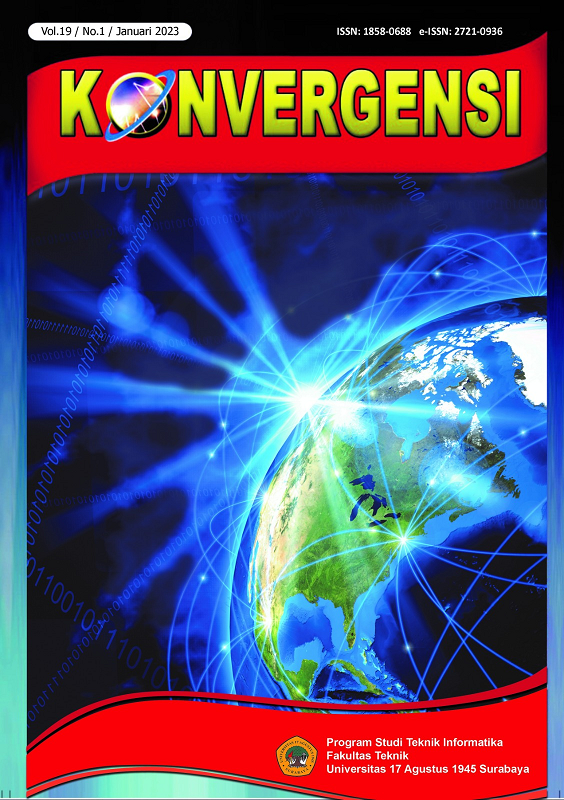Penerapan Algoritma Certainty Factor Dalam Sistem Pakar Berbasis Website Untuk Menganalisis Kemampuan Literasi dan Numerasi Siswa Di Bidang Pendidikan
DOI:
https://doi.org/10.30996/konv.v19i1.8057Keywords:
Expert System; Certainty Factor; Numerical LiteracyAbstract
Education has an important role to play in building people's capacity to use technology and developing their own capacity to create sustainable growth and development. Education is useful for a more valuable life. Education is very important, one of which is literacy and numeracy skills in elementary school children where the competencies are very basic in nature. Based on this discussion, the authors conducted research on the analysis of literacy and numeracy abilities of elementary school students so that educators could find out the strengths and weaknesses of students in the field of numeracy literacy. There are several stages in the first research process, namely conducting interviews with a teacher to obtain data. After getting all the data, an expert system is built using the Certainty Factor Algorithm. The literacy and numeracy expert system works by calculating the value per indicator from experts and students with the CF formula. After the system calculates the results of the diagnosis and special treatment for students will appear. In the final stage, Black Box and System Usability Scale testing was carried out on the application. Testing shows that the proposed system requirements meet expectations and work well. The results of the study show that the performance of the application shows an accuracy value of 85,29% and the results of the SUS test show a value of 71,18 which indicates that this implementation has an acceptance level that meets the standards.
Keywords: Expert System, Certainty Factor, Numerical Literacy
ABSTRAK
Pendidikan memiliki peran penting dalam membangun kapasitas masyarakat untuk menggunakan teknologi dan mengembangkan kapasitas mereka sendiri untuk menciptakan pertumbuhan dan pembangunan yang berkelanjutan. Pendidikan berguna untuk kehidupan yang lebih bernilai. Sangat pentingnya pendidikan salah satunya adalah kemampuan literasi dan numerasi pada anak sekolah dasar dimana yang menjadi kompetensi yang sifatnya sangat dasar. Berdasarkan pembahasan tersebut maka penulis melakukan penelitian tentang analisa kemampuan literasi dan numerasi terhadap siswa sekolah dasar sehingga tenaga pendidik dapat mengetahui kelebihan dan kekurangan siswa di bidang literasi numerasi. Terdapat beberapa tahapan dalam proses penelitian yang pertama yaitu melakukan wawancara kepada seorang guru untuk memperoleh data. Setelah mendapatkan semua data dilakukan pembuatan sistem pakar dengan menggunakan Algoritma Certainty Factor. Sistem pakar literasi dan numerasi bekerja dengan menghitung nilai per indikator dari pakar dan siswa dengan rumus CF. Setelah sistem menghitung maka akan muncul hasil diagnosa dan treatment khusus untuk siswa. Pada tahap terakhir dilakukan pengujian Black Box dan System Usability Scale terhadap aplikasi. Pengujian menunjukkan bahwasanya system requirement yang diusulkan memenuhi harapan dan berjalan dengan baik. Hasil penelitian menunjukkan performa dari aplikasi menunjukkan nilai akurasi sebesar 85,29% dan hasil dari pengujian SUS menunjukkan nilai 71,18 yang mengindikasikan bahwa pelaksanaan ini mempunyai taraf penerimaan yg memenuhi standar.
Kata Kunci: Sistem Pakar, Certainty Factor, Literasi Numerasi
Downloads
Downloads
Published
Issue
Section
License
Authors whose manuscript is published will approve the following provisions:
- The right to publication of all journal material published on the Konvergensi Teknologi Informasi & Komunikasi website is held by the editorial board with the author's knowledge (moral rights remain the property of the author).
- The formal legal provisions for access to digital articles of this electronic journal are subject to the terms of the Creative Commons Attribution-ShareAlike (CC BY-SA) license, which means Konvergensi Teknologi Informasi & Komunikasi reserves the right to store, modify the format, administer in database, maintain and publish articles without requesting permission from the Author as long as it keeps the Author's name as the owner of Copyright.
- Printed and electronic published manuscripts are open access for educational, research and library purposes. In addition to these objectives, the editorial board shall not be liable for violations of copyright law.







